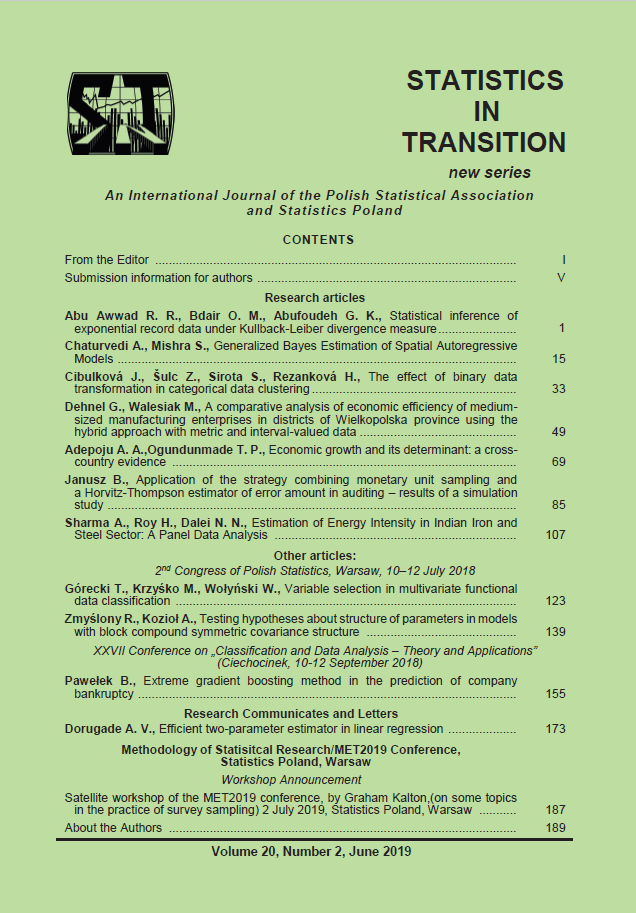ARTICLE
ABSTRACT
In this article we deal with testing the hypotheses of the so-called structured mean vector and the structure of a covariance matrix. For testing the above mentioned hypotheses Jordan algebra properties are used and tests based on best quadratic unbiased estimators (BQUE) are constructed. For convenience coordinate-free approach (see Kruskal (1968) and Drygas (1970)) is used as a tool for characterization of best unbiased estimators and testing hypotheses. To obtain the test for mean vector, linear function of mean vector with the standard inner product in null hypothesis is changed into equivalent hypothesis about some quadratic function of mean parameters (it is shown that both hypotheses are equivalent and testable). In both tests the idea of the positive and negative part of quadratic estimators is applied to get the test, statistics which have F distribution under the null hypothesis. Finally, power functions of the obtained tests are compared with other known tests like LRT or Roy test. For some set for parameters in the model the presented tests have greater power than the above mentioned tests. In the article we present new results of coordinate-free approach and an overview of existing results for estimation and testing hypotheses about BCS models.
KEYWORDS
coordinate-free approach, Jordan algebra, multivariate model, block compound symmetric covariance structure, best unbiased estimators, testing structure of mean vector, testing independence of block variables
REFERENCES
DRYGAS, H., (1970). The Coordinate-Free Approach to Gauss-Markov Estimation, Berlin, Heidelberg: Springer.
FARAUT, J., KORÁNYI, A., (1994). Analysis on symmetric cones, Oxford University Press, Oxford.
FONSECA, M., MEXIA, J. T., ZMYŚLONY, R., (2002). Exact distribution for the generalized F tests. Discussiones Mathematicae Probability and Statistics, 22, pp. 37–51.
FONSECA, M., KOZIOŁ, A., ZMYŚLONY, R., (2018). Testing hypotheses of covariance structure in multivariate data. Electronic Journal of Linear Algebra: International Conference on Matrix Analysis and its Applications, MAT TRIAD 2017, 33, pp. 53–62.
JOHNSON, R. A., WICHERN, D. W., (2007). Applied Multivariate Statistical Analysis, New Jersey, Pearson Prentice Hall, sixth ed., Englewood Cliffs.
JORDAN, P., NEUMANN, von, J., WIGNER, E., (1934). On an algebraic generalization of the quantum mechanical formalism. The Annals of Mathematics, 35 (1), pp. 29–64.
KOZIOŁ, A., ROY, A., FONSECA, M., ZMYŚLONY, R., LEIVA, R., (2018). Freecoordinate estimation for doubly multivariate data. Linear Algebra Appl., 547C, pp. 217–239.
KRUSKAL, W., (1968). When are Gauss-Markov and Least Squares Estimators Identical? A Coordinate-Free Approach. The Annals of Mathematical Statistics, 39 (1), pp. 70–75.
LETAC, G., MASSAM, H., (1998). Quadratic and inverse regressions for Wishart distributions, The Annals of Statistics, 26 (2), pp. 573–595.
MASSAM, H., (1994). An exact decomposition theorem and a unified view of some related distributions for a class of exponential transformations on symmetric cones, The Annals of Statistics, 22 (1), pp. 369–394.
MASSAM, H., NEHER, E., (1997). On transformations and determinants of Wishart variables on symmetric cones, Journal of Theoretical Probability, 10, pp. 867– 902.
MASSAM, H., NEHER, E., (1998). Estimation and testing for lattice conditional independence models on Euclidean Jordan algebras, The Annals of Statistics, 26 (3), pp. 1051–1082.
MICHALSKI, A., ZMYŚLONY, R., (1996). Testing hypothesis for variance components in mixed linear models. Statistics, 27, pp. 297–310.
MICHALSKI, A., ZMYŚLONY, R., (1999). Testing hypotheses for linear functions of parameters in mixed linear models. Tatra Mountains Mathematical Publications, 17, pp. 103–110.
ROY, A., LEIVA, R., ŽEŽULA, I., KLEIN, D., (2015). Testing the equality of mean vectors for paired doubly multivariate observations in blocked compound symmetric covariance matrix setup. Journal of Multivariate Analysis, 137, pp. 50– 60.
ROY, A., ZMYŚLONY, R., FONSECA, M., LEIVA, R., (2016). Optimal estimation for doubly multivariate data in blocked compound symmetric covariance structure, Journal of Multivariate Analysis, 144, pp. 81–90.
SCHAFER, R., (1966). An Introduction to Nonassociative Algebras, Academic Press New York and London.
SEELY, J. F., (1971). Quadratic subspaces and completeness. The Annals of Mathematical Statistics, 42 (2), pp. 710–721.
SEELY, J. F., (1972). Completeness for a family of multivariate normal distributions. The Annals of Mathematical Statistics, 43, pp. 1644–1647.
SEELY, J. F., (1977). Minimal sufficient statistics and completeness for multivariate normal families. Sankhya (Statistics). The Indian Journal of Statistics, 39(2), pp. 170–185.
ZMYŚLONY, R., (1978). A characterization of best linear unbiased estimators in the general linear model, Lecture Notes in Statistics, 2, pp. 365–373.
ZMYŚLONY, R. (1980). Completeness for a family of normal distributions, Mathematical Statistics, Banach Center Publications, 6, pp. 355–357.
ZMYŚLONY, R., ŽEŽULA, I., KOZIOŁ, A., (2018). Application of Jordan Algebra for testing hypotheses about structure of mean vector in model with block compound symmetric covariance structure. Electronic Journal of Linear Algebra: International Conference on Matrix Analysis and its Applications, MAT TRIAD 2017, 33, pp. 41–52.
